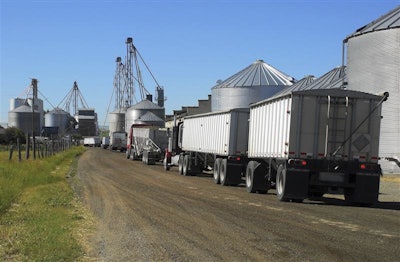
A new rule from the National Highway Traffic Safety Administration (NHTSA) that updates the standards for rear impact guards on commercial trailers may have flown under the radar for feed manufacturers and grain elevators that operate their own vehicle fleets. NHTSA's updated Federal Motor Vehicle Safety Standards (FMVSS) No. 223 and No. 224 mandate enhanced protection for passenger vehicle occupants in the event of rear-end collisions with commercial trailers.
The new requirements call for rear impact guards capable of withstanding crashes at 35 mph, a significant increase from the previous 30 mph standard. These guards must stop passenger compartment intrusion in two critical scenarios:
- Full-width impacts where vehicles hit the center of the trailer
- Partial overlap crashes where 50% of the vehicle width contacts the trailer
The rule took effect on January 11, 2023, and all manufacturers needed to be in full compliance by July 15, 2024.
Safety implications and effects
The updated regulations represent a significant step forward in road safety, albeit with notable implications for the industry. These new standards enhance protection in full-width and partial overlap crash scenarios.
While the safety benefits are clear, it's important to acknowledge the financial considerations for the industry. The upgrade process is estimated to cost approximately US$2.1 million annually across the sector. Additionally, the increased weight of the improved guards contributes to higher fuel consumption, projected to raise industrywide fuel costs by about US$4.43 million per year.
However, it's worth noting that 94% of trailers already meet these enhanced standards, which speaks to the industry's proactive approach to safety. For the remaining fleet, this regulation presents an opportunity to align with best practices in vehicle safety.
The NHTSA projects these improvements will save approximately 0.56 lives and prevent 3.5 serious injuries annually. While these numbers may seem modest, they represent significant progress in mitigating the severity of underride crashes, particularly for occupants of smaller passenger vehicles.
This regulatory update also aligns U.S. standards with those of Transport Canada, creating a unified safety framework across North America. This harmonization may streamline compliance processes for manufacturers operating in both markets.
Industry response and innovation
Industry stakeholders are taking a proactive approach to these new standards. Many fleet operators view this as an opportunity to modernize their equipment and enhance their safety profiles. This forward-thinking attitude is characteristic of an industry that has long prioritized innovation in the face of regulatory changes and market demands.
"KT Pacer invested in a complete redesign of the rear impact guard, inclusive of finite element analysis (FEA) and impact testing, ultimately leading to certification documents showing the rear impact guard design met requirements," said Carl J. Kirpes, president, KT Pacer.
Addressing the material changes necessitated by the new standards, Kirpes adds: "KT Pacer identified and sourced a high-strength material and coupled that with design engineering to ensure the proper force and energy absorption requirements were met."
Trailers and semitrailers weighing more than 10,000 pounds are affected by the rule. However, some vehicles have exemptions:
- Wheels-back vehicles
- Low-chassis vehicles
- Special-purpose vehicles
Implementation timeline and industry preparedness
Full compliance was required by July 15, 2024, so any vehicle on the road today needs to be compliant with the new rule. However, Kirpes notes a concerning trend: "In discussing the updated rear impact guard requirements with customers, KT Pacer noticed that many buyers and end users of feed transportation equipment were unaware of the updated rear impact guard requirements."
The updated NHTSA regulations could significantly influence liability considerations for companies that operate a fleet. For companies that fully comply with the new standards, this could potentially reduce their liability exposure in rear-end collision scenarios. In the event of an accident, compliance with these enhanced safety measures may serve as a strong defense against claims of negligence or inadequate safety precautions.
Conversely, failure to meet these new standards could increase a company's liability risk. In legal proceedings after an accident, non-compliance might be viewed as negligence, potentially leading to higher damages or settlements.
It's crucial for feed manufacturers and grain elevators to document their compliance efforts meticulously. This documentation could prove invaluable in demonstrating due diligence and commitment to safety standards, potentially mitigating liability in accident cases.
Kirpes addresses this issue: "KT Pacer's approach to product liability has not changed. For buyers and operators, the awareness of the product liability as it relates to rear impact guards (or any portion of the equipment they buy and use for that matter) is important, and the recent verdicts highlight the importance of aligning with an equipment manufacturer that has the commitment and the resources to invest in product enhancements such as the rear impact guard updates."
Opportunity for fleet review and compliance
The updated NHTSA standards provide an excellent catalyst for feed manufacturers and grain elevators to conduct a comprehensive review of their fleets. This process can yield benefits beyond mere compliance, including:
- Upgrading to the new standards can significantly reduce the risk of severe injuries in rear-end collisions.
- Demonstrating a commitment to safety can enhance the company's image among customers and partners.
- Proactive compliance may lead to more favorable insurance terms.
- A thorough fleet review can identify other areas for improvement or maintenance.
The new NHTSA regulations on rear impact guards present a challenge and an opportunity for feed manufacturers and grain elevators to enhance their fleet safety and compliance. The deadline may have passed, but for grain elevators and feed manufacturers that have not yet made sure they are in compliance, now is the perfect time to ensure your fleet meets these crucial safety standards and to potentially reduce liability risks, conduct a comprehensive review of your trailers and implement necessary upgrades.
.jpg?auto=format%2Ccompress&crop=faces&fit=crop&h=48&q=70&w=48)

















